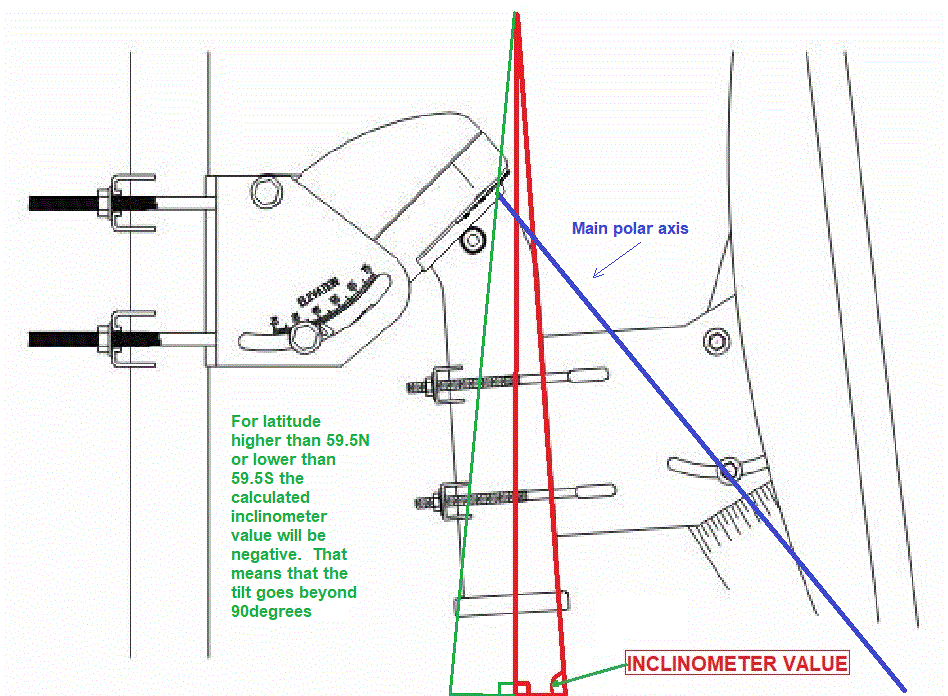At the poles there it is not possible to
receive geostationary satellites.
A geostationaty satellite will only be visible approxematly
74000 meters above the pole.
The theoretical limit for receiving geostationary satellites is near a latitude
of 81.91°North/South

Polarmount angles
diseqc rotor angles
Diseqc rotor angles
Polarity Tilt

Looking towards the satellite.
ERRORS
:
Use . (period) as decimal separator.
The
scripts uses cookies to store default values like position e.t.c.
. Make sure Cookies is allowed on your computer if you wan't this
function to work. Error could occur if I need to change the
cookie format. Just "OK" the errors an select site
& satelite and the Cookie should take the new format.
All calculations is done "on change"
SITE
LOCATION :
Can be selected from list or the position
can be entered manually. The site location from the listbox can
be stored as default site location. If you don't find you're site
in the listbox the location can be entered manually.
The first time the calculator is loaded there is a cookie error. Just select the
position again and everytning should be stored in the new Cookie and no error
should occur the next time the calculator is used.
SATELLITE
ORBITAL POSITION:
Values between 270-360 is converted to 270-360 East Atlantic
Ocean Region. 359 East AOR gives the same result as 1 West.
SATELLITE
NAME:
Choose satellite name and the angle calculations will be done.
Satellite orbitposition can also be entered manually.
OFFSET
ANTENNAS
Offset angle on a offset antenna. Not the same value for all
offset antennas . Can be changed before angle calculations !
AZIMUTH
&POLARMOUNT HOUR ANGLE :
180 degrees=south. 360(0) degrees= north. 270 degrees = West , 90
degrees East
The polarmount hour-angle (x-angle on figure) is 180 deg. when
the site longitude and satellite longitude is equal in nothern
hemisphere. The hourangle-angle is 360 (or 0...) deg. at the same
conditions in the southern hemisphere.
Polarmount hour-angle can be used to calibrate H-H mounts which counts linear pulses/degree. If a H-H mount is calibrated on normal azimuth calculations it will not give correct values.
When a H-H mount is calibrated after the hour-angle it is possible to calculate the counter value for any position.
Click here to see a graph of polarmout x angle vs azimuth at 60 deg. N
POLARITY
ANGLE (TILT):
Looking towards the satellite. The turning
direction is not equal on all systems. Negtive values is just
used to show the turning direction.
A satellite on the same longitude as the receiving/transmitting
station will have 0 degrees as horisontal polarisation. Vertical
polarisation on 90 degrees clockwise( -90 degrees Counter
Clockwise)
On some satellites the polarity angle can be offset from the calculated one.
On the France Telecom Satellites there is a polarisation offset of 20 degrees from the calculated ones.
DECLINATION
ANGLE:
For adjusting polarmounts correctly.
UP/DOWN LINKDELAY:
The signal travels at light speed (300 000km/s). The uplink delay in milliseconds is
simply the distance to the satellite in km divided by 300
The up/downlink total delay is only correct if the uplink and downlink is at the same site
If its at different sites simply add uplink delays for the two different sites to find total delay
THE
TIME WHEN SUN AZIMUTH EQUALS SATELLITE AZIMUTH:
At the UTC/GMT time calculated the sun's shadow direction equals
the satellites azimuth direction which will give a good
indication in which direction the satellite is located. The date
on the computer system is used.
Can be used to make sure there is no tree's in the satellites
direction ....
This calculation is disabled for latitudes near +/-4degrees from equator because the calculations does not work. On equator there are only two azimuth angles east (90 deg) or west (270 deg.). Antennas is not pointed after azimuth angle.
At the two periods of the year when there is sun interference , any sunny spot will mean that there is a free line of sight to the satellite. Suninterference outage times can be calculated using one of the calculators linked at http://www.satellite-calculations.com
href="http://www.satellite-calculations.com">http://www.satellite-calculations.com
CALIBRATION OF H-H HOUNT PULSE CALCULATIONS:
Use the lookangles calculator and calculate hourangle for a position far east. Then calculate for a position
far west. Find the pulse counter values for this two positions. Now the pulses per hourangle degree
can be calculated. Pulse/degree= Difference in hourangle/ difference in pulse counter.
Then select a satellite in the lookangles calculator and input the countervalue for that position and the
direction which the value increase. As soon as the values is input the calculator calculates hourangle and
store the settings in a cookie. Your HH values should then be used the next time you use the calculator.
Some values:
Fibo120cm - 8.686868 pulses per degree
Fibo90 cm - 1.811024 pulses per degree
KTI Proform H180 - 11.4339 pulses per. degree
Be aware that calibrating a H-H polarmount with Azimuth will never be accurate for angles
far west and east. Thats why you should use hourangle.
For small antennas the error can probably be ignored.
The resaon why can be seen here
The pulses/degree value might also be different with different positioners.
SOME FORMULAS:
Polaraxsis
angle=90-Site Latitude-Polaraxis correction angle
Declination from horisontal plane=Declination+Polaraxsis angle
History:
20©06 Jens T. Satre